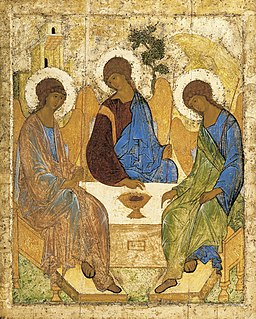Free Resource- Holy Trinity Sunday Picture Book (Reproducible)
This coming Sunday is celebrated by many as Holy Trinity Sunday, arguably the only major festival of the liturgical year that is focused on a theological doctrine, rather than a person, an event, or a ritual. In the Narrative Lectionary summer series, it also begins the Psalms “Unit” with a short hymn of praise to the LORD, Psalm 100.
Honestly, this makes two pieces of the Sunday difficult for our younger disciples to follow and understand. Children focus best on the concrete, rather than the abstract. Stories are concrete and easy to follow, assuming they are told in a way that helps the listeners follow along. This means, in part, that the narrative passages of Scripture (the stories) are easier for children to pay attention to and at least understand the basic plot. The non-narrative passages of Scripture, including the laws/instructions, wisdom literature, prophets, and epistles, are harder to follow and understand (even for adults!). This means, in order to make sure the children are engaged while we read these portions of Scripture (almost all summer long), then additional care needs to be given to make sure children can participate fully.
One way to engage children (and adults) in the psalms is to spend some time helping them to understand the occasion or meaning of the song. It can be the occasion as best understood by scholars, or simply something more general. For Psalm 100, the singers are happy, excited about what God has done for them, that they belong to God, and that God loves them. We can all relate to being excited and the comfort of belonging and being loved. Mini-stories can even be found in the psalms (some might call them metaphors or imagery) that can be pulled out and emphasized.
The second part of the day is the celebration of the Holy Trinity. The Trinity is both incredibly simple (There is only one God; and the Father/Creator, the Son/Jesus, and the Holy Spirit are all God.) and incredibly complex (like how that works). While the history, arguments, and explanations of the doctrine of the Trinity are extremely fascinating (to me anyway), most people may not want to take the time to go in depth here. So, here are a few (mostly) concrete points you can emphasize:
- The Trinity is a word that means “Three in One”.
- Jesus is God (and human). This means that God loves you so much that God became a human being (while still staying God) to show us what God is like, and to die and be raised from the dead. [I did say mostly concrete.]
- The Holy Spirit is God. This means that the Holy Spirit that lives inside of you is the one who created everything you can see (and not see)!
- God is so much bigger than we can every understand (even when you become an adult and go to school for a really long time). This is what we mean when we say that God is mysterious, or that the Holy Trinity is a mystery. [Today’s free resource explains the mystery of God in a picture book!]
- The most important things to understand about God are found in today’s psalm: We belong to God and God will always love us!
- Perhaps not for young kids, but here is a fun video explaining all of the trouble you can get in when you try to explain the Trinity: Patrick’s Bad Analogies.
-Gregory Rawn (Publisher)
This week’s FREE resource is from the Spirit and Truth: Teaching Kids the Heart of Worship (PK-2nd) curriculum, which has units that explain the major words and concepts of worship in the liturgy, as well as the meaning behind eleven of the major church festivals. Each lesson includes a story (both as a picture book and a longer story book) as well as a full lesson plan with activities to explore the concepts covered with multiple learning styles. You can also see our Spirit and Truth: Teaching Kids the Heart of Worship (3rd-6th) curriculum, which uses humorous, readers-theater skits instead of stories to explain the liturgy and church festivals.


Leave a Reply